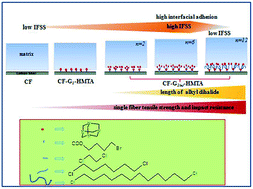Interfacial properties and impact toughness of dendritic hexamethylenetetramine functionalized carbon fiber with varying chain lengths
Abstract
In order to understand the effects of chain length on the interfacial adhesion of PAN-based carbon fiber (CF)/epoxy composites, dendritic hexamethylenetetramine (HMTA) was functionalized on carbon fibers through quaternary ammonium salt reaction using alkyl dihalide of varying chain length [Cl(CH2)nCl, n = 2, 6 and 12]. Fourier transform infrared spectroscopy (FTIR), Raman spectra and X-ray photoelectron spectroscopy (XPS) confirmed the successful grafting of dendritic HMTA and alkyl dihalide. AFM images showed that dendritic HMTA modified CF surfaces enhanced roughness, and this effect was more pronounced with increasing alkyl dihalide chain length. The results of dynamic contact angle (DCA) and interfacial shear strength (IFSS) demonstrated that the surface energy and interfacial adhesion increased and then decreased with the chain length of alkyl dihalide. The tensile strength and impact roughness of the composites enhanced as the alkyl dihalide chain length grew. Moreover, the reinforcing and toughening mechanisms were also discussed.


 Please wait while we load your content...
Please wait while we load your content...